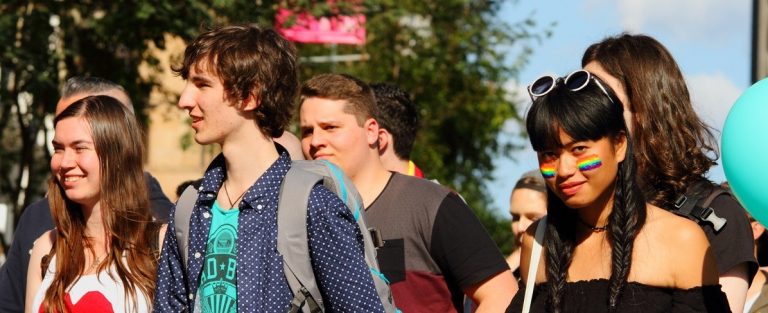
The Eastern Cape is South Africa’s most conservative province when it comes to attitudes about homosexuality. Even in spaces that might be considered more liberal – like university campuses – gender non-conforming students and those who belong to sexual minorities face open discrimination.
This is happening even though discrimination based on sexual orientation is outlawed by South African’s post-apartheid Constitution.
Research into sexual orientation and gender identity at South Africa’s university is becoming more common. It aims to advance scientific evidence and generate knowledge that can help universities protect sexual minorities. Too often, sexual minorities are “invisible”. Students are forced to remain in the closet for fear of stigmatisation.
In other cases, students with a same-sex sexual orientation are subjected to corrective therapy, instead of affirmation. Lesbian, gay, bisexual, transgender and intersex (LGBTI) student societies struggle to receive recognition or even to be registered by student representative councils.
A new study conducted at one Eastern Cape university offers some ideas about how to make sexual minorities more visible and encourage learning about sexuality and gender. This will involve tackling deeply-held religious and cultural convictions.
What we found
Dr Abaver and his colleagues are involved in ongoing research about sexual orientation at the Walter Sisulu University in the Eastern Cape. It’s a sprawling public university with more than 24,000 students and about 2,500 staff. They live and work across four campuses, with 13 satellite sites.
One of these studies was a cross-sectional survey. It involved 126 participants aged between 18 and 40, who were located on two of the university’s campuses: Mthatha and Potsdam.
The study’s aim was to explore knowledge and perceptions towards LGBTI students. It asked questions about sexual orientation and gender identity. Sexual orientation refers to preference for a romantic or sexual partner. Gender identity, meanwhile, refers to the private or public performance of gender.
Data was collected with a questionnaire administered among students and staff. The findings reflected overwhelmingly negative attitudes.
https://twitter.com/evandesu/status/859989196999622656
About 3.2 percent of the research subjects identified as homosexual, lesbian or bisexual. Respondents were not asked whether they were open about their sexuality.
More than half of the respondents (60.3 percent) knew a gender non-conforming person whose presentation in terms of their dress code didn’t match cisgender expectations. Cisgender refers to a person whose gender identity matches the biological sex description assigned at birth – for instance, a person who was born a male and lives as a man.
Just more than 35 percent of the respondents knew of students or staff who occasionally or regularly had sexual relationships with people of same sex.
And the vast majority of respondents – 74.6 percent – said they believed sexual intercourse with people of the same sex was abnormal and unnatural – a belief often driven by religion. Many did not question their churches’ stance on homosexuality. They viewed heterosexuality as the only “right” way of living.
There was a glimmer of hope on this front: About 25.3 percent of respondents reported their religion encouraged them to accept people of any sexual orientation. This is a sign there are – albeit small – shifts in the religious sector in terms of doctrines around sexual minorities.
Cultural attitudes
Culture was another reason people gave for decrying homosexuality. In this study, 70 percent of participants said their culture did not accept same-sex relationships. This presents culture as lived outside of people’s lives and as something one can join and or opt out of. But this is not true. There are LGBTI people in every culture, in all societies, and they are embraced to various degrees.
Cultural explanations of sexual orientation and gender identity are not uncommon, as research conducted by Professor Nduna, also in the Eastern Cape – though not at a university – has shown.
It's pretty progressive when a college application asks for your birth sex and gender identity. I'm mildly surprised.
— Jspivo (@TheGrimGoodbye) March 21, 2017
But if culture is a concept that describes a way of life, then people who identify with a particular culture should take responsibility and publicly contest “their culture” when it misrepresents reality. That’s the premise and stance of the Destabilising Heteronormativity project. It advocates for LGBTI people’s rights, particularly in higher education institutions. It involves heterosexual people in the fight against discrimination of sexual minorities.
Another arm of the project challenges religion and scriptures through the work of the House of Rainbow and the International Network of Religious Leaders Living With or Personally Affected by HIV and AIDS.
There are several other ways to tackle heterosexism and discrimination against LGTBI people. Heterosexism refers to prejudice against sexual minorities by heterosexuals.
Towards change
Student organisations can play an important role here. Walter Sisulu University’s LGBTI community is doing good work to mobilise against various forms of prejudice, stigma and heterosexism.
Xolisani Mpama, a peer educator and field worker in the Destabilise Heteronormativity project at Walter Sisulu University has also moved to deal with the “invisibility” of LGBTI students and staff. He has set up a support group on the university’s Ibika campus.
Changes to the formal university curriculum could make a real difference, too.
About 58.7 percent of the respondents said talks in classes would be valuable and 55.6 percent believed community programmes would help to raise awareness about sexual orientation and gender identity.
This would help to address the knowledge gap in the university community about same-sex relationships.
Sadly, the university curriculum, both within and outside of the classroom, is still largely founded on the remnants of draconian colonial and apartheid laws. So it’s very heterosexist and cisgender in its orientation. The binaries of male and female and men and women are evident across courses and disciplines. Course content assumes heteronormativity.
It’s important to remember, while students and others call for curriculum transformation more broadly, that enlightened knowledge about sexual orientation, gender identity and heterosexism should be prioritised.
By Mzi Nduna, Associate Professor in Psychology, University of the Witwatersrand and Dominic Targema Abaver, Senior Researcher in Public Health, Walter Sisulu University
This article was originally published on The Conversation. Read the original article.
Liked this? Then you’ll love these…
Malaysia: Rights groups upset over university’s nixing of LGBT student event
Student activist case shows China’s ‘slow progress’ on LGBT rights – HRW







